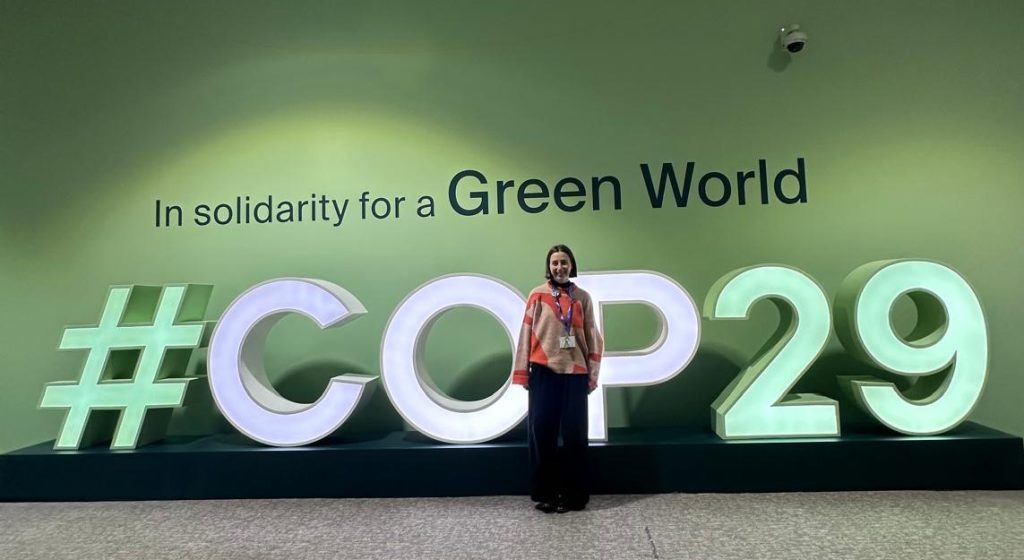
Written by Thea Stevens, PhD student with SCENARIO DTP, University of Reading
I was lucky enough to be accepted as one of the PhD students the Walker Institute took to COP29 Baku, Azerbaijan. I almost didn’t apply to attend. After all, getting to Azerbaijan and being there as an ‘observer’ felt like it might not be justifiable when it takes 6 hours on a flight just to get there. I eventually decided to apply excited but also slightly conflicted about why I should be the one to go.
I had heard before I went that COPs are one of the largest global conferences with attendees from every background. Even with this preparation, my initial thought when I got to COP was – ‘wow this is massive’. It took a solid 10 minutes to walk fast from one end of the conference centre to the other.
The setting for COP was in the Olympic stadium of Baku (even though Azerbaijan has never hosted the Olympics). However, (apart from a moment a volunteer opened a side door which gave a view of thousands of seats) this was quickly forgotten. There was only one window that I could find, and the rest of the space was a set of huge temporary structures built inside and around the stadium.
To navigate how much was going on, I began categorising events into three main groups: the pavilions, the side events and the negotiations.
Atmosphere 1: Pavilions
The pavilions were based in a side area big enough to be its own conference. Each country, NGO and international organisation had their own elaborately decorated pavilion, which all had their own daily schedule of talks. While the talks tended to be small, and you might be only sitting a maximum of four or five meters away from the panel, headphones were needed to hear over the noise of all the other events going on in the area.
I attended talks from how to address the power dynamics between researchers and those in areas being researched to topics such as the impact of lithium mines on Indigenous peoples located in the ‘Lithium Triangle’ in South America. These discussions brought the true scope of the environmental and human disasters we are facing to the forefront; people’s personal stories giving climate change realities a face, identity, and personal meaning.
Atmosphere 2: Side Events
Walking out of this area and into the side events you enter a more formal atmosphere. The focus here was more on topics related to the negotiations and included press conferences and panel talks. These events became more important as the conference went on as the press conferences became a major information source about the developments of the negotiations. These rooms tended to be stuffed full of people, some standing, all eager to hear the latest opinions and stances on the details of the updated negotiated text. This was where the energy and hard truths about progress were voiced. I often left these events reminded about the significance of ambition in the negotiations. I hope some of the negotiators and ministers managed to take a moment to attend at least one of these talks as a reminder of why ambition was needed.
Atmosphere 3: Negotiations
Negotiations were typically structured around a large rectangle of tables, every party sat around the perimeter; headsets again needed to communicate between either side of the rectangle. At times, observers were allowed to sit watching around the fringes of this, but as the conference wore on, this privilege was lessened creating a divide between the voices outside of these rooms and the decision-making process. Despite how much pre-reading you had or hadn’t done on the topic in discussion, the progress, procedure and meaning of these sessions were often hard to follow. Progress felt slow and tedious, time could often feel wasted disagreeing on procedures as simple as ‘why are we being brought back into the conference room – and disagreements veiled in the language of referenced paragraphs. I learnt to spot contentious points from a sudden flurry of countries indicating they too have a contribution to make. Following negotiations became a game of chasing the latest reference: which page number, which numbered paragraph, which bracket were they discussing this time? These paragraphs and brackets with their legal monotone discussions are the hidden dialogue and currency of COP and the reason for all the noise and energy taking place outside these rooms.
Sitting in on these negotiations is where the enormity of ambition and geopolitical complexity of bilateral agreements becomes visible. Countries – with vastly different agendas and core beliefs – coming around a table trying to agree on something is an absurdly ambitious arrangement. Reducing fossil fuel consumption is unlike another problem we face; their presence is pervasive in all of our lives. Fossil fuels are a bedrock of wealth and power in our global political economy. Despite alternative energies booming, and 2024 confirmed as the warmest year on record, this makes fossil fuels hard for the world to walk away from at the speed we need to do so.
Whilst COP can be critiqued for being slow and disappointing their remains hope in the vision of these bilateral negotiations. Given the increase in conflict and geopolitical instability these past few years, I left COP with an appreciation for the fact that there is still a negotiating table.
Conclusions: Power Dynamics and All the Emissions
In spite of the emissions involved in coordinating a global conference, and the continued importance of keeping these as low as possible, I am convinced that the coming together of this number of people, experiences, and perspectives from all over the planet is one of the most crucial parts of COP.
While simply waiting in a queue to get into a negotiation, I met a delegate from an NGO based in South Africa representing communities being guided on how to access financial aid. She stressed that amendments being made during different negotiations were having a direct impact on the accessibility of these funds. Having her watching and voicing opinions to negotiators between events provides a powerful reminder of the people impacted. Observers acted as a reminder to the negotiators that the progress – or lack thereof – is under global scrutiny and that amendments made have consequences. The noise and mass of people at COP mean the negotiators cannot ignore the power held in their deliberations.

